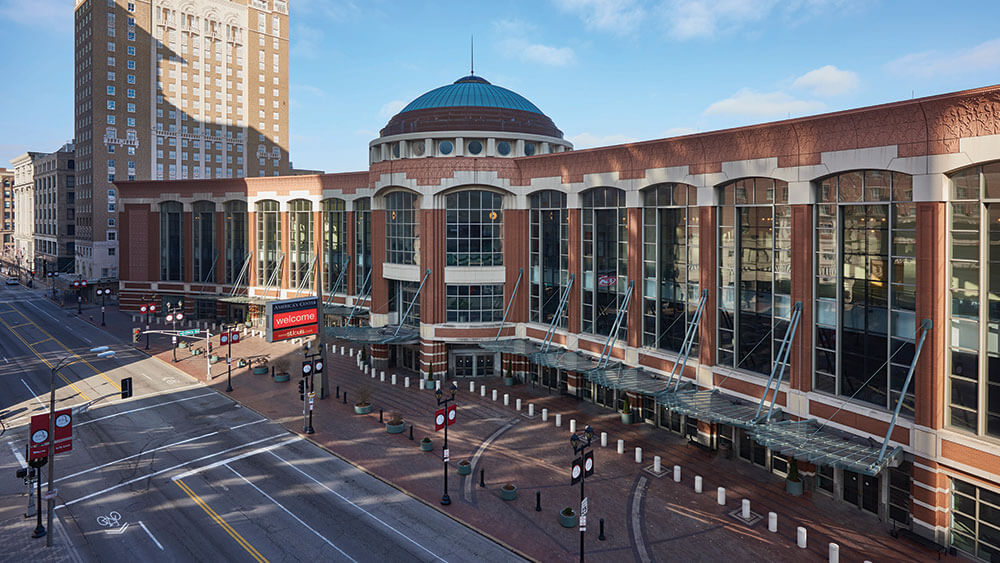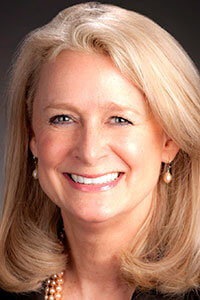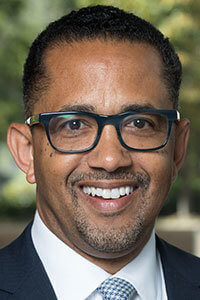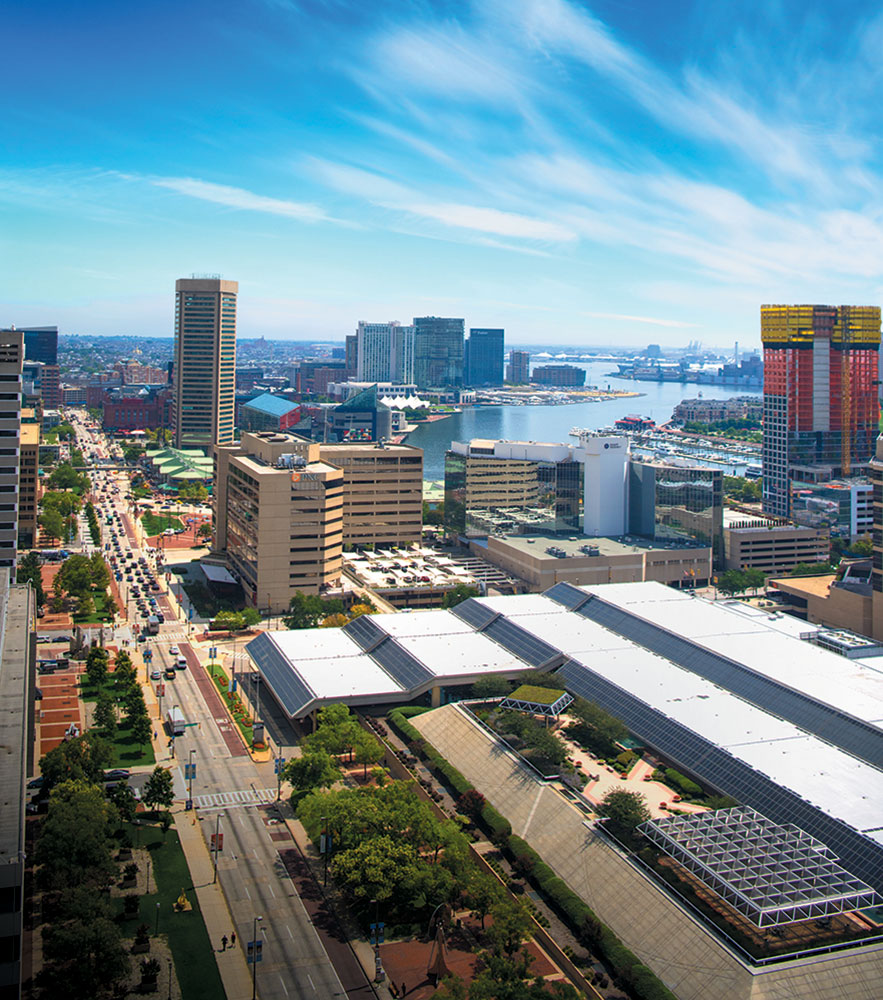
The America’s Center Convention Complex in St. Louis will be expanded under a long-gestating plan that was approved in April. (Courtesy Explore St. Louis)
Walk into a convention center in any major city in America, and it likely will take you days to get your bearings. Massive ballrooms, multiple floors of breakout rooms, exhibit halls the size of football fields, and miles of skyways that connect buildings — these facilities take up long city blocks to accommodate sizeable groups hungry for knowledge and networking, and exhibitors whose oversized booths are packed with new products. But the most successful convention centers have footprints that are never done expanding.
As event organizers attract bigger audiences, they often outgrow centers that once hosted them. But expanding those centers is a tall order, since most involve some type of public funding. Getting buy-in for this kind of major investment requires navigating a complex political maze, wrangling support, and articulating why a convention center matters to a city’s economy.

Kitty Ratcliffe
In other words, Kitty Ratcliffe, president of Explore St. Louis, told Convene, “These are always difficult projects to get approved.”
Ratcliffe has a deep appreciation of those difficulties. Over the past few years, she has been at the helm of the AC Next Gen Project, a plan to expand the America’s Center Convention Complex in St. Louis that comes with an estimated price tag of $175 million. The plan received the final go-ahead from the St. Louis County Council on April 16.
The challenges of winning that approval have been compounded by geography. The city of St. Louis is not located in St. Louis County, so getting approval for the expansion required sign-off from two different legislative bodies: the St. Louis City Board of Aldermen and the St. Louis County Council. Including the mayor and the comptroller, there were approximately 40 people with decision-making powers involved.
“The only way to effectively educate people on the need for this kind of project is to do it one-on-one,” Ratcliffe said. “That takes a huge amount of time. We have been inviting each of the aldermen and the council members over at their convenience. We took them on a tour of the building to talk through what we proposed to do and how much it would cost.”
Satisfying Multiple Stakeholders
“There will always be people you won’t get to say ‘yes,’” Ratcliffe said, reflecting on the process of tallying votes throughout those conversations. However, she approached her work with optimism, focusing on inspiring every person to support the expansion plans, and she managed to rally overwhelming support. Of the 27 aldermen who cast votes on the bill, there were only three no votes and one abstention.
The county, though, presented a bigger challenge. “Because the city owns the building,” Ratcliffe said, “we needed to get the county to recognize the regional benefits of the project and to articulate that the building does not compete against other local arenas or concert venues.”
An analysis of all the employees who work in the convention center provided valuable evidence of the role that center plays in the surrounding area’s economy. “Forty percent of the employees live in the county,” Ratcliffe said. “So it’s a true jobs generator. We made the connections that helped the council members feel good about supporting the project.”
Planning for the Future
Those connections paid off, and Ratcliffe expects that the first shovel will be in the ground sometime in the spring of 2020, but there is no official starting date yet. When the work does begin, she’s most excited about what she calls “the least sexy” aspect of the new build, but one that’s “very critical”: more loading docks. “We’ll be able to reorient the exhibit hall and triple the number of loading docks,” she said. “It’s an essential component for us to host shows that have a lot of freight and move them in and out much faster.”
The other key pieces of the project will be more obvious to attendees, organizers, and residents of St. Louis. A new ballroom — somewhere between 60,000 and 65,000 square feet — will be part of the construction, and it will open to a full city block of new green space that can be used for outdoor events or a place where attendees can take a break from the indoors. The plans will transform the building, which was originally built in 1977. While the city invested $42 million in some functional improvements, such as passenger elevators and redoing the restrooms between 2007 and 2011, Ratcliffe said that work didn’t really “reimagine what the facility could be for the future.” Now, that’s exactly what she plans to do.
“This project will take this building and put it in a good place for the next 30 to 40 years,” she said. “It gives us a place that can grow and adapt as the industry continues to evolve.”
Before it all happens, though, there is still work to finish, illustrating the long and involved nature of this process. Ratcliffe said that all the bond documents need final approval, and financial advisors for the city and the county will need to agree to terms — so “there is more negotiating to be done.”
Big Plans in Baltimore
Meanwhile, Al Hutchinson, president and CEO of Visit Baltimore, is at an earlier stage in the convention-center expansion process. He’s still rallying to get the support necessary to move from the talking stage to a groundbreaking ceremony. “We know that our center is at or near capacity,” Hutchinson told Convene. “We have very few available dates for groups to book, and some of our existing clients have outgrown the center. We know that we are losing some economic impact from a convention and meeting perspective.”

Al Hutchinson
Between 2012 and 2017, Hutchinson said that Baltimore lost nearly two million hotel room nights due to a lack of space and lack of available dates. “This is a big deal,” he said. “We are in the economic development business, and our largest asset is the convention center. If we’re serious as a city and a state about growing our economic footprint, we need to take the opportunity to expand the center very seriously.”
Hutchinson is working to please multiple audiences. Two-thirds of the debt for the convention center is paid by the state, and one-third is paid by the city. Funding decisions have to be approved by city officials and state lawmakers, and that combination means that he has to help a lot of leaders — many of whom do not live anywhere near the city of Baltimore — understand why an expansion is essential. “We continue to educate our political stakeholders and convince them that it makes sense for the city of Baltimore,” Hutchinson said.
Those efforts are never easy, but things are moving along. In mid-April, the state’s General Assembly approved a bill for the next phase of the detailed planning studies including cost estimating and financial modeling based on the design and technical work that is currently in progress. That study will be conducted by the Maryland Stadium Authority, the organization taking the lead on the project. By the end of the year, results will be in to help Hutchinson make a stronger case for the expansion and renovation to move forward.
The lawmakers represent key voices in moving the plans forward, but the constituents they represent are always on Hutchinson’s mind. “We are constantly talking to our residents,” he said. “Our residents are our most valuable assets, so we have to reach them to underscore the value of tourism on a local level and throughout the state. It’s a broad conversation that we have been having for many years.”
David McMillin is a Convene associate editor.

Plans are in the early stages to expand the Baltimore Convention Center (lower right). (Courtesy Visit Baltimore)
